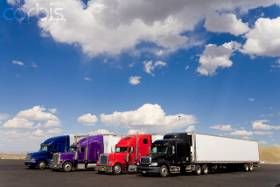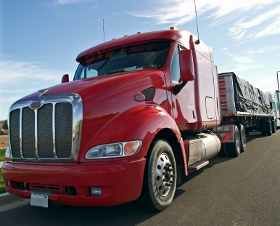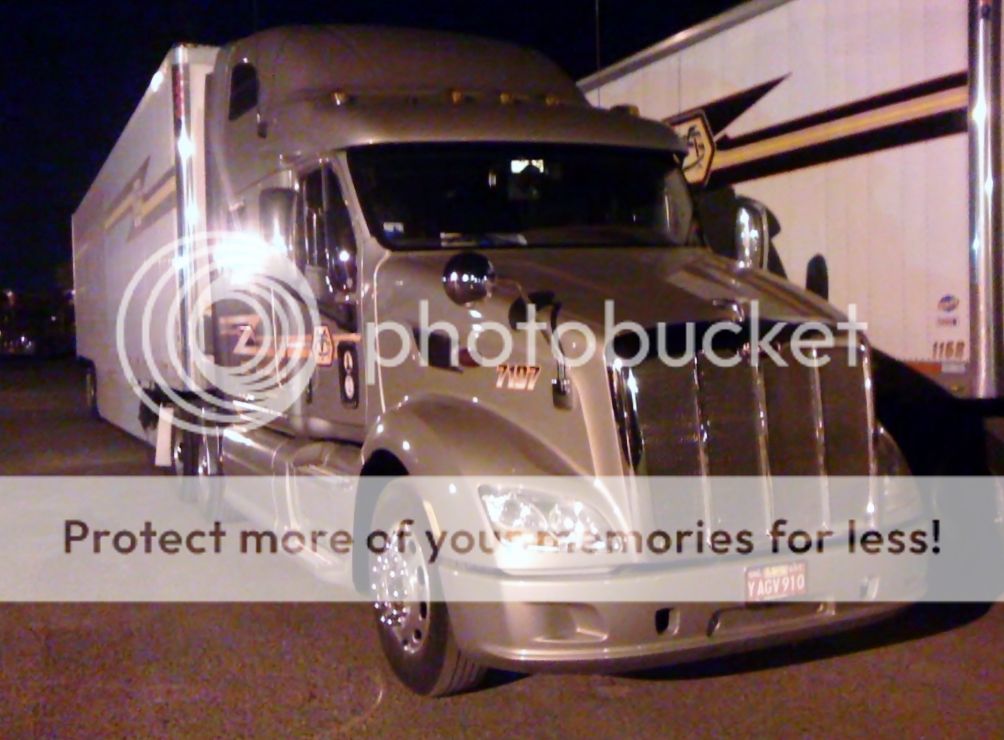Progress
Topic 172 | Page 1
These type of questions are extremely difficult to answer because there are so many variables involved - the speed you're backing, the length of the tractor, the length of the trailer, how far you're out away from the spot - all kinds of factors.
I can't tell you much in the way of specifics about "wait til the front trailer axle is at the cone and turn the wheel 1 1/4 turns" - that kind of thing. There's no way to really nail it down like that. But I can tell you something that's going to help you in the long run.
Remember that the cues they're giving you like "Pull 20 feet from the cone and back up until your driver's door is next to the cone and keep it cranked until your mirror is near the white stripe" - that kind of stuff is only going to be helpful during training to get you "in the ballpark" when it comes to making different maneuvers. The most important thing for you to do each and every single time you get in that truck is to be aware of what you're doing so that when you get out of the truck you can evaluate exactly what you did and how it turned out. Evaluate the angles and how quickly they changed as you were backing. Evaluate the lag time from the time you started steering until the trailer reacted. Evaluate whether you over-steered or under-steered. And then watch others as they do it so you can get a new perspective and even more repetitions to learn from.
In the short run, memorizing cues is helpful to get the ball rolling. But I love what you said - you want to perfect it. That's the perfect approach to take. I drove for 15 years and I always learned something every single time I backed that truck. I was absolutely as good as anyone out there, but in my mind I'll bet I didn't back into a spot perfectly more than a few times a year. There were always little misses - even if it was only by a few inches. I was striving for perfection each time and when I fell short I would evaluate what I did, what went wrong, and what I thought would have given me better results.
I wish I could give you concrete answers, but every situation will be completely different out there. Analyzing every move you make and every move the other students make and striving for perfection will get your backing skills pretty solid in a relatively short amount of time.
Finally, I'll say this. When you watch someone backing who's a true pro - the best of the best - they steer very gently and as little as possible. When you watch someone who's new, they steer hard and fast and make a lot of corrections back and forth because they're constantly over-steering or under-steering. You want to strive to be smooth and gentle. Anticipate what the trailer will do and what your next move will be.

Glad to hear school is going well for you!
One thing I wish the company accelerated training did was give us more time backing. I do get some with the trainer, but it can be limited because we are always under pressure to get the next load there.

Troupador has it about right. You won't get to REALLY work on your backing until you are out on your own...and you HAVE to back it in the spot....its one of those OJT things that are soooo important....but never given enough practice time....you'll get it....just as Redgator !!!
HOS:
Hours Of Service
HOS refers to the logbook hours of service regulations.
Brett - I sometimes wonder if I will ever be as mature as you. I spend almost as much time beating myself up as I do evaluating. I doubt I've had 5 hours behind the wheel on the pad, and before this week I'd never been in truck before with the engine running. I know I should cut myself some slack, but I don't want to graduate just by the skin of my teeth...I want to be the best there is.
And, Troubador, I hear ya. That's what bothers me the most...the fear of not getting enough practice time on the skills pad. They keep stressing, "this is college, not a trucking school." Well, okay then, in college if a student needs extra help, tutoring is available. What about it? If a student is willing to put in the extra time and pay an extra fee, there should be a way and a means to get the extra practice. But, NOOOooooo! It's against policy.
Starcar...yes, I know, but I have to get out there first!!
Sorry. I just had one of those days that so often follows a good one. A day where I could do nothing right. I really need a restart this weekend! 
HOS:
Hours Of Service
HOS refers to the logbook hours of service regulations.Sorry. I just had one of those days that so often follows a good one. A day where I could do nothing right. I really need a restart this weekend!
Hey, we totally understand. But ya know, hopefully you're gonna look back on this time in school with very fond memories of what it felt like to learn how to drive a rig - and those memories are priceless. Strive for perfection, but don't be afraid to have some fun with it and enjoy it too.
Also, once you get out on the road doing it for real the stress level will be much higher than it is now and the days much longer. One of the most important things you'll need to do is conserve your energy and keep a clear mind. Just like you're practicing backing and shifting, practice keeping a clear, relaxed mind. You have a lot of work ahead of you just to get through the rest of schooling and on-the-road training. Then you'll have several months of solo running which are also some very stressful but exciting times. You don't want to wear yourself out and cloud your mind with unnecessary stress and pressure of any sort - whether it originates internally or from external sources.
So go for it - shoot for being the best in your class and eventually as good as any driver on the road. I'm the same way myself. But keep yourself calm and relaxed. Most importantly, expect a lot of yourself but never, ever get down on yourself. You'll have plenty of ups and downs. Not every day is going to be your best performance so just accept that from time to time and roll with it.
Trucking is 95% mental and 5% physical. Almost nobody ever gets out of trucking because they couldn't brake, shift, or back up. They get out because mentally it becomes overwhelming. It's a constant battle every driver in America fights internally every day, and a lot of drivers are losing that battle unfortunately. So keep your spirits high and your mind clear and calm. You'll think more clearly, perform much better, have a lot more energy, and of course enjoy yourself more.
HOS:
Hours Of Service
HOS refers to the logbook hours of service regulations.
Brett what is the mental stress that is so overwhelming, is it the solitude, the pressure form companies, getting deliveries, or just all of it?

The stress is everything from shipper times,directions,routing,traffic,detours,dispatchers,maneuvering the truck safely in tight areas with people/cars ignoring ya and just driving by even though they in the way.
Shipper:
The customer who is shipping the freight. This is where the driver will pick up a load and then deliver it to the receiver or consignee.
Dispatcher:
Dispatcher, Fleet Manager, Driver Manager
The primary person a driver communicates with at his/her company. A dispatcher can play many roles, depending on the company's structure. Dispatchers may assign freight, file requests for home time, relay messages between the driver and management, inform customer service of any delays, change appointment times, and report information to the load planners.Yeah, it really is everything. There are just countless variables in every moment of every day. Some are the obvious ones like traffic, weather, tight schedules, breakdowns, etc.
But there are plenty of unexpected ones that show up...things you might not think about until you've been out there for a little while. For instance, you go out on the road and have all of these amazing experiences. You live this life that at times is insanely difficult, at times you can't believe they're paying you for it, and there's just nothing like it. Unfortunately when you get home and you're all excited to tell your family and friends about the amazing experiences you've had, nobody can relate. Sure, they'll smile and laugh with ya a bit, but you quickly realize they can't possibly understand what it felt like to be you...to experience everything you experienced.
Over time that gap widens as you spend more time on the road, and you realize your life has gone off on a tangent from the lives of your family and friends back home. They have their thing and you have yours. And you wind up spending about 21 out of every 24 hours completely alone out there in that rig just wandering the country and that just adds to the feeling of detachment from the life you knew before.
For some people, that's no big deal. For others, it's a rude awakening. And for a few, it's just too much to bear. And of course it comes very early in your career - during training and those first few months running solo when the stress of learning the job is at its absolute peak.
There's a lot going on those first 6 months or so of your trucking career. The culture shock of suddenly living on the road and being a trucker is beyond description. The stress of learning what seems to be an unimaginable amount of stuff all at once is overwhelming at times.
The culture shock is what's so difficult to explain to people. It's nearly impossible to prepare someone thoroughly for what they're about to experience. You just really have to take it one day at a time and keep moving forward, keep learning every day.
Everyone comes to our website obsessing over what company to go to work for and I make a tremendous effort to help people understand that picking that first company is almost trivial compared with the difficulties you'll face once you get out there. That's why I don't harp on "choose this company...stay away from that company, pick this school, avoid that one", etc.
Instead, I try to instill how critically important a great attitude is. I try to keep people thinking positive and make sure they stay calm, relaxed, and confident. Because shifting, backing, and steering aren't nearly as difficult as adjusting to the culture shock and stress of life on the road. And the company you choose won't matter much as long as you're a safe, reliable, hard working driver with a great attitude. You'll do well anywhere you go if that's the case.
I always tell people that trucking is an absolutely fantastic life if you're cut out for it, but regardless, it's almost never easy...especially that first year. There's a steep learning curve and a lot of hard lessons to learn. Nobody gets a free pass in that regard.
HOS:
Hours Of Service
HOS refers to the logbook hours of service regulations.OOS:
When a violation by either a driver or company is confirmed, an out-of-service order removes either the driver or the vehicle from the roadway until the violation is corrected.

Brett, thanks for your last post! Very inspiring words to me!! G MAN
New Reply:
New! Check out our help videos for a better understanding of our forum features

















Preview:
This topic has the following tags:
Attending Truck Driving School Life On The Road Reports From CDL Training Tips For Backing Truck Driver Training Truck Driving Lifestyle







 TT On Facebook
TT On Facebook
The double clutching is coming along nicely. Down shifting is still a pain, but that will improve with practice. I drove through one of the most nightmarish traffic spots in the Jacksonville area today. My instructor said if I can drive a big rig through there, I can drive anywhere. I'm thinking of having Blanding Boulevard tattooed on my arm!
I performed my first offset parking maneuver today without being walked through it, which brings me to my question for anyone who wants to pitch in and help. When I did my offset, I had to pull forward before I could back in the slot. This is allowed, but I want to do it purdy. So, here's where I'm having difficulty. You do a hard turn, then a counter-steer to get your tractor and trailer squared at a 45 degree angle toward the slot. Then you center your steering wheel and do a straight back toward the center cone. At what point do you stop and do a hard turn to get the back of your trailer into the slot? Do your tandems need to be centered at the center cone, or what?
Any suggestions would be greatly appreciated.
Tandems:
Tandem Axles
A set of axles spaced close together, legally defined as more than 40 and less than 96 inches apart by the USDOT. Drivers tend to refer to the tandem axles on their trailer as just "tandems". You might hear a driver say, "I'm 400 pounds overweight on my tandems", referring to his trailer tandems, not his tractor tandems. Tractor tandems are generally just referred to as "drives" which is short for "drive axles".
Tandem:
Tandem Axles
A set of axles spaced close together, legally defined as more than 40 and less than 96 inches apart by the USDOT. Drivers tend to refer to the tandem axles on their trailer as just "tandems". You might hear a driver say, "I'm 400 pounds overweight on my tandems", referring to his trailer tandems, not his tractor tandems. Tractor tandems are generally just referred to as "drives" which is short for "drive axles".
Double Clutch:
To engage and then disengage the clutch twice for every gear change.
When double clutching you will push in the clutch, take the gearshift out of gear, release the clutch, press the clutch in again, shift the gearshift into the next gear, then release the clutch.
This is done on standard transmissions which do not have synchronizers in them, like those found in almost all Class A trucks.
Double Clutching:
To engage and then disengage the clutch twice for every gear change.
When double clutching you will push in the clutch, take the gearshift out of gear, release the clutch, press the clutch in again, shift the gearshift into the next gear, then release the clutch.
This is done on standard transmissions which do not have synchronizers in them, like those found in almost all Class A trucks.